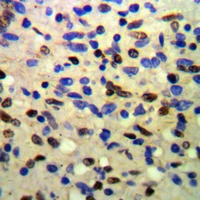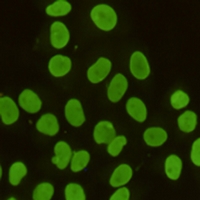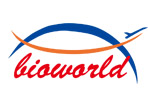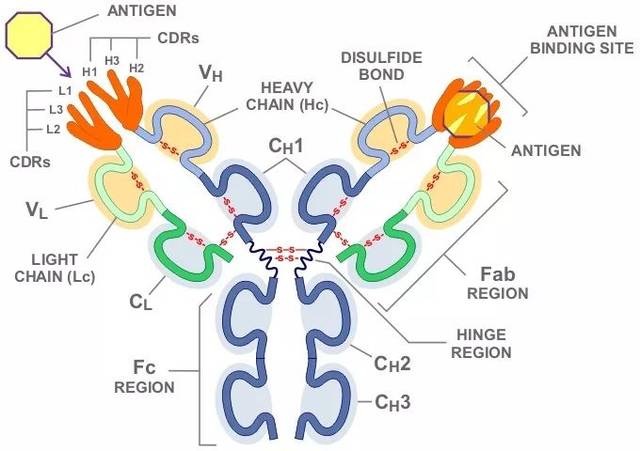Product Name :
TIF1 beta monoclonal antibody Background :
TIF1β is a member of the TIF1 (transcriptional intermediary factor 1) family, a group of transcriptional regulators that play key roles in development and differentiation. Members of this family are characterized by the presence of two conserved motifs – an N-terminal RING-B box-coiled-coil motif and a C-terminal PHD finger and bromodomain unit . TIF1β is a corepressor for KRAB (Kruppel associated box) domain containing zinc finger proteins. The KRAB domain containing zinc finger proteins are a large group of transcription factors that are vertebrate-specific, varied in their expression patterns between species, and thought to regulate gene transcription programs that control speciation .TIF1β has been shown to be essential for early embryonic development and spermatogenesis . It functions to either activate or repress transcription in response to environmental or developmental signals by chromatin remodeling and histone modification. The recruitment and association of TIF1β with heterochromatin protein (HP1) is essential for transcriptional repression, and for progression through differentiation of F9 embryonic carcinoma cells . TIF1β also plays a role in the DNA damage response. Phosphorylation of TIF1β on Ser824 occurs in an ATM-dependent manner in response to genotoxic stress and is thought to be essential for chromatin relaxation, which is in turn required for the DNA damage response .t Product :
Liquid in PBS containing 50% glycerol, 0.5% BSA and 0.02% sodium azide, pH 7.3. Storage&Stability :
Store at 4°C short term. Aliquot and store at -20°C long term. Avoid freeze-thaw cycles. Specificity :
Recognizes endogenous levels of TIF1 beta protein. Immunogen :
Purified recombinant human KAP1 / TIF1 beta protein fragments expressed in E.coli. Conjugate :
Unconjugated Modification :
Unmodification
TIF1 beta monoclonal antibody Background :
TIF1β is a member of the TIF1 (transcriptional intermediary factor 1) family, a group of transcriptional regulators that play key roles in development and differentiation. Members of this family are characterized by the presence of two conserved motifs – an N-terminal RING-B box-coiled-coil motif and a C-terminal PHD finger and bromodomain unit . TIF1β is a corepressor for KRAB (Kruppel associated box) domain containing zinc finger proteins. The KRAB domain containing zinc finger proteins are a large group of transcription factors that are vertebrate-specific, varied in their expression patterns between species, and thought to regulate gene transcription programs that control speciation .TIF1β has been shown to be essential for early embryonic development and spermatogenesis . It functions to either activate or repress transcription in response to environmental or developmental signals by chromatin remodeling and histone modification. The recruitment and association of TIF1β with heterochromatin protein (HP1) is essential for transcriptional repression, and for progression through differentiation of F9 embryonic carcinoma cells . TIF1β also plays a role in the DNA damage response. Phosphorylation of TIF1β on Ser824 occurs in an ATM-dependent manner in response to genotoxic stress and is thought to be essential for chromatin relaxation, which is in turn required for the DNA damage response .t Product :
Liquid in PBS containing 50% glycerol, 0.5% BSA and 0.02% sodium azide, pH 7.3. Storage&Stability :
Store at 4°C short term. Aliquot and store at -20°C long term. Avoid freeze-thaw cycles. Specificity :
Recognizes endogenous levels of TIF1 beta protein. Immunogen :
Purified recombinant human KAP1 / TIF1 beta protein fragments expressed in E.coli. Conjugate :
Unconjugated Modification :
Unmodification
-
 Western blot analysis of TIF1 beta expression in 293T (A), HepG2 (B) whole cell lysates.
Western blot analysis of TIF1 beta expression in 293T (A), HepG2 (B) whole cell lysates. -
 Immunohistochemical analysis of TIF1 beta staining in human spleen formalin fixed paraffin embedded tissue section. The section was pre-treated using heat mediated antigen retrieval with sodium citrate buffer (pH 6.107). The section was then incubated with the antibody at room temperature and detected using an HRP conjugated compact polymer system. DAB was used as the chromogen. The section was then counterstained with haematoxylin and mounted with DPX.
Immunohistochemical analysis of TIF1 beta staining in human spleen formalin fixed paraffin embedded tissue section. The section was pre-treated using heat mediated antigen retrieval with sodium citrate buffer (pH 6.107). The section was then incubated with the antibody at room temperature and detected using an HRP conjugated compact polymer system. DAB was used as the chromogen. The section was then counterstained with haematoxylin and mounted with DPX. -
 Immunohistochemical analysis of TIF1 beta staining in human spleen formalin fixed paraffin embedded tissue section. The section was pre-treated using heat mediated antigen retrieval with sodium citrate buffer (pH 6.107). The section was then incubated with the antibody at room temperature and detected using an HRP conjugated compact polymer system. DAB was used as the chromogen. The section was then counterstained with haematoxylin and mounted with DPX.
Immunohistochemical analysis of TIF1 beta staining in human spleen formalin fixed paraffin embedded tissue section. The section was pre-treated using heat mediated antigen retrieval with sodium citrate buffer (pH 6.107). The section was then incubated with the antibody at room temperature and detected using an HRP conjugated compact polymer system. DAB was used as the chromogen. The section was then counterstained with haematoxylin and mounted with DPX.
Bioworld Biotech only provide peptides for our antibodies and do not provide additional peptide customization services.
Price/Size :
USD 368/1mg/vial
Tips:
For phospho antibody, we provide phospho peptide(0.5mg) and non-phospho peptide(0.5mg).Describe :
Blocking peptides are peptides that bind specifically to the target antibody and block antibody binding. These peptide usually contains the epitope recognized by the antibody. Antibodies bound to the blocking peptide no longer bind to the epitope on the target protein. This mechanism is useful when non-specific binding is an issue, for example, in Western blotting (WB) and Immunohistochemistry (IHC). By comparing the staining from the blocked antibody versus the antibody alone, one can see which staining is specific; Specific binding will be absent from the western blot or IHC performed with the neutralized antibody.Formula:
Synthetic peptide was lyophilized with 100% acetonitrile and is supplied as a powder. Reconstitute with 0.1 ml DI water for a final concentration of 10 mg/ml.The purity is >90%,tested by HPLC and MS.
Storage:
The freeze-dried powder is more stable. For short time at 2-8°C. For long term storage store at -20°C.
Note :
This product is for research use only (RUO only). Not for use in diagnostic or therapeutic procedures.
 TIF1 beta monoclonal antibody
TIF1 beta monoclonal antibody  Datasheet
Datasheet COA
COA MSDS
MSDS SHIP
SHIP